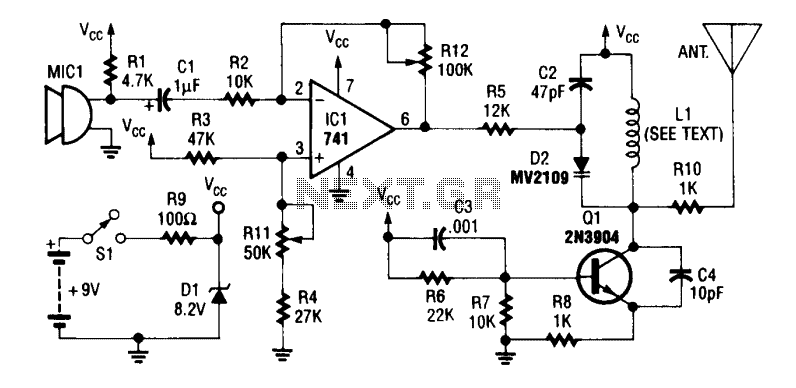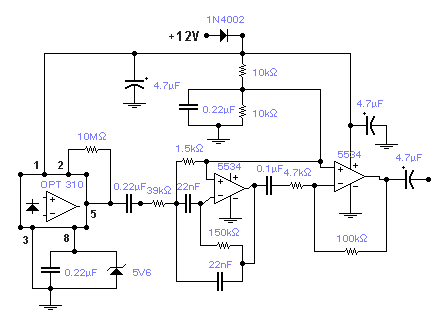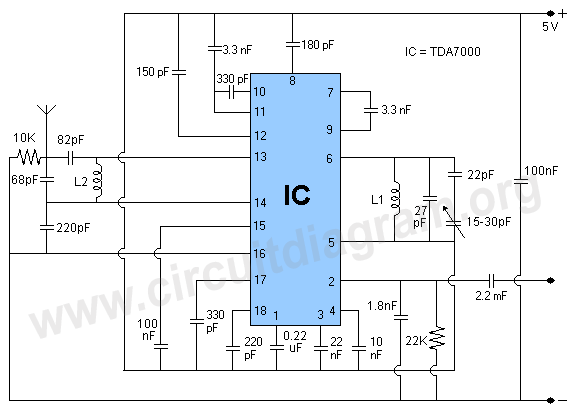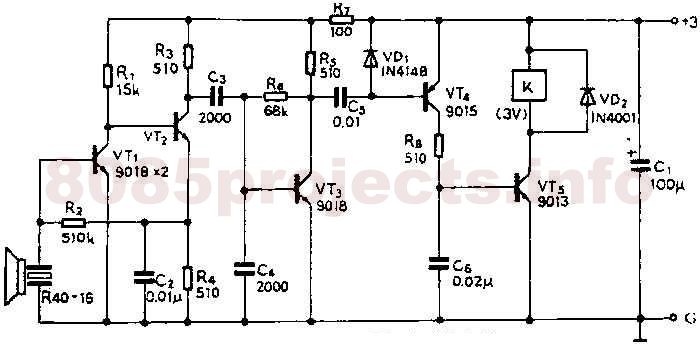
1.8MHz AM transmitter and receiver

Before starting on the receiver side of the Chatterbox, a final review of the transmitter is necessary. The Chatterbox transmitter is constructed separately, as many builders may wish to use it alongside an existing receiver operating at 1.8 MHz. It is assumed that an existing antenna tuner and low-pass filter unit will be utilized with the transmitter. However, if the complete transmitter and receiver combination is intended to function as a standalone unit, a suitable low-pass filter is required to mitigate potential harmonics. This filter can be integrated into the transmitter or used externally in conjunction with a small antenna tuner. The choice of configuration depends on the dimensions of the casing and whether the project is assembled as separate units or as a compact system. With the change-over switching described in the previous article, the transmitter is compatible with any 1.8 MHz receiver. If a suitable receiver is not available, a simple single-board receiver can be added, as outlined here. It is important to note that this receiver is not designed for long-distance (DX) operations but is intended for local AM nets. The receiver section is based on the TDA1072A AM receiver, an affordable chip that performs all necessary functions from the antenna to the audio stages. The sensitivity and signal handling capabilities of the TDA1072A make it suitable for this application. The chip also supports several features that are not utilized in this design, although some of these features are accessible on the PCB for potential incorporation. For instance, the chip includes an S-meter output, a muting facility, and a buffered oscillator output for driving a frequency counter. The circuit closely adheres to the manufacturer's specification sheet. The incoming signal is filtered using a high-pass filter (L6, wound on a toroid) and associated capacitors, along with a two-stage band-pass filter consisting of T2 and T3. The high-pass filter is necessary as the receiver operates near the medium wave broadcasting band. Constructing the toroid for L6 is straightforward, requiring winding 24 turns of 0.4 or 0.5 mm enamelled copper wire on a T37-2 core. A local commercial broadcasting station at the upper end of the medium wave band can interfere with reception in certain locations. The high-pass filter is designed to eliminate unwanted pop music interference. Manual tuning for the band-pass filter is achieved through a polyvaricon capacitor (C36), allowing for the peaking of desired band signals while minimizing out-of-band signals. The band is tuned using a variable capacitor (C39) in conjunction with T4, providing stable tuning across the band. The variable capacitor (C39) is a standard value of 75 pF, with a 100 pF alternative available, adequately covering the entire band. This tuning capacitor is mounted directly on the printed circuit board, with its ground connection established through the mounting nut to the PCB. To prevent issues with poor connections, an additional wire is connected between the tag on the moving vanes and the ground plane on the PCB. The intermediate frequency (IF) at 455 kHz is filtered using a CFW455HT ceramic filter and an IF transformer (T5) positioned between the mixer output (pin 1) and the IF amplifier (pins 3 and 4). It is possible to inject a beat frequency oscillator (BFO) signal at pin 4 to enable the receiver to handle continuous wave (CW) and single sideband (SSB) reception. Several radio amateurs have successfully adapted this design for CW and SSB reception. However, injecting a 455 kHz signal at pin 4 may trigger the internal automatic gain control (AGC), which can reduce the overall gain of the receiver to an undesirable level.
The Chatterbox transmitter and receiver system is designed to provide effective communication for local amateur radio operations. The modular approach allows for flexibility in integration with existing equipment, making it suitable for various configurations. The use of the TDA1072A chip ensures cost-effectiveness while maintaining adequate performance for the intended application. Careful attention to the construction of filters and tuning components is essential for optimal signal quality. The incorporation of additional features from the TDA1072A chip can enhance functionality and provide users with more control over their reception capabilities. Overall, this design serves as a practical solution for amateur radio enthusiasts seeking to establish reliable communication within their local networks.Before starting on the receiver side of the` Chatterbox`, we ought to take a final look at the transmitter itself. The Chatterbox transmitter is built separately, because many constructors will want to use it in conjunction with an existing receiver on 1.
8MHz. It`s been assumed that an existing antenna tuner and low-pass filter unit will be used w ith the transmitter. However, if you intend to use the complete transmitter and receiver combination as a `stand alone` unit, it will be necessary to use a suitable low-pass filter to reduce potential harmonics. A filter of this sort can be built into the transmitter, or it can be an outboard type used in conjunction with a small antenna tuner.
What the individual constructor does of course, will depend on the size of casing and whether or not the project is built as separates or as one small unit. With the change-over switching described in the previous article, the transmitter can be used with any 1.
8MHz receiver. If you don`t have a suitable set, you can add a simple single board receiver of the sort described here. However, bear in mind that the receiver is not a DX model and it`s designed for using the Chatterbox combination in local a.
m. nets. The receiver section is based on the TDA1072A a. m. receiver i. e. This is an inexpensive chip which performs all the functions of an a. m. receiver between the antenna and the audio stages. The TDA1072A`s sensitivity and signal handling capabilities are such that it`s suitable for this application. The i. e. also supports several features not used in this design. Some of the features are made available on the p. c. b. , should you wish to incorporate them in the receiver. For example, the chip provides an S-meter output, a muting facility and a buffered oscillator output for driving a frequency counter.
The circuit is shown in Fig. 2. 1, and it closely follows the manufacturer`s specification sheet. The incoming signal is filtered with a high-passfilter, L6 (wound on a toroid) and associated capacitors, and a two stage band-pass filter, comprising of T2 and T3. The high-pass filter was included because the receiver operates close to the medium wave broadcasting band.
Winding the toroid for L6 is a simple job and it only requires a little concentration for a neat job. All you need to do is wind 24 turns of 0. 4 or 0. 5mm enamelled copper wire on a T37-2 core. I have a local commercial broadcasting station at the top end of the medium waveband that can light bulbs in my location in Rochdale!
The high-pass filter was included to kill the pop music breakthrough. The band-pass filter has manual tuning provided by a polyvaricon capacitor, C36, to peak the wanted band signals and reduce the out-of-band signals. The band is tuned using a variable capacitor, C39, in conjunction with T4. Although the TDA 1072A was designed for varicap tuning, this arrangement allows for very stable tuning over the band.
The variable capacitor, C39, is a standard value, 75pF, (a 100pF may be used as an alternative) which more than covers the whole band. This tuning capacitor is mounted directly on the printed circuit board. The ground connection on C39, is made through the mounting nut to the p. c. b. To avoid any problems with poor connections, I also added a wire between the tag to the moving vanes and the ground plane on the top of the printed circuit board.
The i. f. at455kHz, is filtered by using a CFW455HT ceramic filter and an i. f. transformer, T5, placed between the mixer output, pin 1, and the i. f. amplifier, pins 3 and 4. It`s possible to inject a b. f. o. signal at pin 4, to make the receiver available for c. w. and s. s. b. reception. Several radio amateurs have used this i. e. to make a c. w. and s. s. b. receiver. I tried injecting a 455kHz signal at pin 4, but found that it triggered the internal a. g. c. This reduced the overall gain of the receiver, to what I considered to be an un 🔗 External reference
The Chatterbox transmitter and receiver system is designed to provide effective communication for local amateur radio operations. The modular approach allows for flexibility in integration with existing equipment, making it suitable for various configurations. The use of the TDA1072A chip ensures cost-effectiveness while maintaining adequate performance for the intended application. Careful attention to the construction of filters and tuning components is essential for optimal signal quality. The incorporation of additional features from the TDA1072A chip can enhance functionality and provide users with more control over their reception capabilities. Overall, this design serves as a practical solution for amateur radio enthusiasts seeking to establish reliable communication within their local networks.Before starting on the receiver side of the` Chatterbox`, we ought to take a final look at the transmitter itself. The Chatterbox transmitter is built separately, because many constructors will want to use it in conjunction with an existing receiver on 1.
8MHz. It`s been assumed that an existing antenna tuner and low-pass filter unit will be used w ith the transmitter. However, if you intend to use the complete transmitter and receiver combination as a `stand alone` unit, it will be necessary to use a suitable low-pass filter to reduce potential harmonics. A filter of this sort can be built into the transmitter, or it can be an outboard type used in conjunction with a small antenna tuner.
What the individual constructor does of course, will depend on the size of casing and whether or not the project is built as separates or as one small unit. With the change-over switching described in the previous article, the transmitter can be used with any 1.
8MHz receiver. If you don`t have a suitable set, you can add a simple single board receiver of the sort described here. However, bear in mind that the receiver is not a DX model and it`s designed for using the Chatterbox combination in local a.
m. nets. The receiver section is based on the TDA1072A a. m. receiver i. e. This is an inexpensive chip which performs all the functions of an a. m. receiver between the antenna and the audio stages. The TDA1072A`s sensitivity and signal handling capabilities are such that it`s suitable for this application. The i. e. also supports several features not used in this design. Some of the features are made available on the p. c. b. , should you wish to incorporate them in the receiver. For example, the chip provides an S-meter output, a muting facility and a buffered oscillator output for driving a frequency counter.
The circuit is shown in Fig. 2. 1, and it closely follows the manufacturer`s specification sheet. The incoming signal is filtered with a high-passfilter, L6 (wound on a toroid) and associated capacitors, and a two stage band-pass filter, comprising of T2 and T3. The high-pass filter was included because the receiver operates close to the medium wave broadcasting band.
Winding the toroid for L6 is a simple job and it only requires a little concentration for a neat job. All you need to do is wind 24 turns of 0. 4 or 0. 5mm enamelled copper wire on a T37-2 core. I have a local commercial broadcasting station at the top end of the medium waveband that can light bulbs in my location in Rochdale!
The high-pass filter was included to kill the pop music breakthrough. The band-pass filter has manual tuning provided by a polyvaricon capacitor, C36, to peak the wanted band signals and reduce the out-of-band signals. The band is tuned using a variable capacitor, C39, in conjunction with T4. Although the TDA 1072A was designed for varicap tuning, this arrangement allows for very stable tuning over the band.
The variable capacitor, C39, is a standard value, 75pF, (a 100pF may be used as an alternative) which more than covers the whole band. This tuning capacitor is mounted directly on the printed circuit board. The ground connection on C39, is made through the mounting nut to the p. c. b. To avoid any problems with poor connections, I also added a wire between the tag to the moving vanes and the ground plane on the top of the printed circuit board.
The i. f. at455kHz, is filtered by using a CFW455HT ceramic filter and an i. f. transformer, T5, placed between the mixer output, pin 1, and the i. f. amplifier, pins 3 and 4. It`s possible to inject a b. f. o. signal at pin 4, to make the receiver available for c. w. and s. s. b. reception. Several radio amateurs have used this i. e. to make a c. w. and s. s. b. receiver. I tried injecting a 455kHz signal at pin 4, but found that it triggered the internal a. g. c. This reduced the overall gain of the receiver, to what I considered to be an un 🔗 External reference





